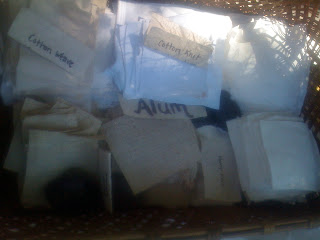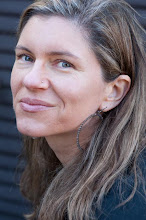Today I sit with the question: If we are all so clear about eating organic, why are we not wearing organic clothing? Our conventional clothes contain toxic fertilizers/pesticides/herbicides/insecticides, heavy metals, endocrine disruptors, teratogens (causes birth defects) and carcinogens. The question lingers from a blissful day yesterday spent at a "Native Dye" workshop with my friends and colleague, eco-artist Rebecca Burgess, at the California School of Herbal Studies (CSHS) in Forestville, CA (County of Sonoma).
Rebecca was very kind to let me crash the workshop, which she has taught twice before at CSHS, and to speak to the students on the topic of "Toxic Endpoints of Conventional Clothing: Endocrine Disruption, Heavy Metal Exposure & Cancer." My unofficial title: "These Jeans Are Killing Me."
A friend texted me, after hearing the title of my talk, "Look at you going all NRDC on us."
A friend texted me, after hearing the title of my talk, "Look at you going all NRDC on us."
Good point.
After driving at high speed the 72 miles from Oakland to Forestville and dragging my 5-year-old daughter behind me (she was off school for Sukkot) at 7am, I turned onto the long liminal driveway to CSHS.
"Donkeys!" shrieked Maya, my youngest kid, her impatience with the drive a distant memory.
"Yes, Donkeys!" I affirmed. "Or Burros?" I'm not so good at distinguishing the two. Too rounded to be horses. Not llamas. Woah, I'm noticing animals again. We entered sacred space. Hassles of leaving the house so early and traffic on the 101 receded as we both took in the landscape: luscious herbs and flowers, silence, farm animals, brilliants smells and sights of Indian summer in Sonoma.
We parked and walked into the red building ("The Barn") that you see above. I'm a conventionally-trained doctor and never take my kids with me to work. When I did in the past, I get people who look at my young kid, then me, then the kid, then quickly away with a withering sigh.
I walk into CSHS and a group of twenty-something women, all beaming warm and inviting energy at us with shining eyes, greet and welcome us. Estrogen and oxytocin (the hormone of love and bonding) boils over the pot in this place. My daughter grins ear-to-ear and settles right in, ready to make new friends.
I set up our Powerpoint and look for tea - my stainless steel commuter mug needs a refill. There's a big hot water urn in the corner that I spy, but... uh, where's the tea? There's a conspicuous lack of tea bag options next to the hot water. Oh, I get it. All these women were nursing Mason jars filled with steeping flowers and plant bits. Hello, they are Herbalism Students! These peeps are way beyond tea bags.
Rebecca and I finished setting up her steaming vats of natural dye: indigo (naturally fermented) black walnut, coffeeberry, California sage, Madrone, Eucalyptus. Powerpoint begins. Rebecca flashes her slide that is the segue to my brief presentation - how conventional dye causes all kinds of health problems (short list that I've augmented: lymphoma, bladder cancer, asthma, contact dermatitis, hypothyroidism, estrogen dominance), and naturally-dyed clothing actually has healing properties (again, Rebecca's work to which I've added my own thoughts), such as:
- Pokeberry (see photo below) acts as a lymphatic cleanser
- Woad - contains 20 times as much glucobrassica as brocolli and I hypothesize may improve estrogen dominance similar to DIM (di-indole methane)
- Horsetail - decreases bone loss in women
Radical idea of clothes that heal, not hurt.
Here's Rebecca preparing a pokeberry dye vat for us:
Those pretty berries above got smooshed and made into this gorgeous dye vat - remember this cleanses your lymphatics to work with these berries and wear them.
And here is an organic cotton food/snack bag I dyed with the pokeberry. Take it to the farmer's market next time you're gathering apples or persimmons.
This feels like prayer. My kind of prayer.
Now why bother, you might ask. Great question. Part of my presentation was to take a common toxic clothing item - your beloved jeans and tell the back story of how they were made. In the US, women on average own 8 pair of jeans. I'm no exception and happen to love my Sevens for All Mankind, my Dolces and my Luckies.
I know there are heavy metals used in getting that pretty denim color, and pesticides and fertilizer used in growing the cotton. Do conventional pesticides and fertilizer act as endocrine disruptors and slow my thyroid and stimulate my estrogen receptors in my boobs? Um, yes. I never really put it together as I did while preparing yesterday's presentation - and to state very directly: my beloved jeans are hurting my health. Here's a few soundbites:
- 2/3 pounds of toxic pesticides and fertilizer are used to make one pair of jeans
- water from conventional denim textile companies is full of heavy metals such as mercury, lead, cadmium, chrome, copper, zinc, antimony
- 7 million pounds of toxic chemicals are used annually for cotton in California alone
As the local Chief Medical Officer in Guarngzhou, Dr. Tony Lu, states, this black muck is full of chemicals that may be: "neurotoxic, carcinogenic, they disrupt the endocrine system. They cause cancer of different organs."
People, we have alternatives. We are on board with organic food, but let's take the next step and get mindful about what we put against our skin, and especially the skin of the most vulnerable among us, fetuses in utero, babies, children.
Here are a few more pics of the brilliant Rebecca Burgess, spreading the good word.
Let's find some foxy organic cotton jeans, colored with natural dyes. My Seven jeans now hold less appeal, Now, I'm eye-ing my Lululemon brightly-colored yogawear in a whole new way.
If you're worried the alternative is not pretty, check out some of the samples from our workshop yesterday.
While it's true that I'm a relative beginner at changing out my wardrobe, Rebecca is much farther along of the path. She writes a gorgeous blog, and walks the talk - she now wears for the next year clothing that is sourced and dyed with local resources within a 150-mile radius. The experiment is called "fibershed" and I can't wait to check her heavy metals before and after. So much fun for this integrative gynecologist!












1 comment:
This is such a lucid, humorous, honest indictment of our clothes-- thank you! The beauty is the alternative is right there, completely available to us..
Post a Comment